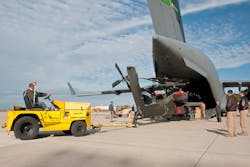Microgrid at Fort Hood Army Base in Texas successfully islands from Utility Grid
Power management firm Eaton and military partners have worked together on demonstrating and islanding a microgrid project which sustained electric operations at an airfield in Fort Hood, Texas, independently from the utility grid.
The demonstration proved that the military microgrid could be seamlessly islanded apart from the grid. The system at Fort Hood, an Army base, utilized solar power, energy storage and on-site power generators which, with control systems, provided up to 14 days uninterrupted power at the Robert Gray Army Airfield, according to Eaton.
“Eaton’s demonstration of long-term resiliency at a critical asset such as the Robert Gray Army Airfield is an important milestone for the implementation of resilient infrastructure at military installations,” said Bryan Farrens, senior manager, Government Programs, Eaton. “Air-strike training, for example, is a key mission that historically would be at-risk if there was a long-term loss of utility power. With this effort, we are proving that with intelligent controls, installations like Fort Hood across the military can rely more on sustainable resources such as solar to meet the resilience targets.”
The company partnered with the U.S. Army Engineer Research and Development Center, Construction Engineering Research Laboratory and the Department of Public Works at Fort Hood. Eaton researchers were led by Senior Principal Engineer Vijay Bhavaraju.
Eaton’s microgrid controller leveraged the company’s automatic transfer switches and recloser controller in islanding the Gray Airfield from the grid. The effort is the result of grants Eaton received from the U.S. Department of Defense.
Previous news reports indicate that Fort Hood can receive up to 40 percent of its power from solar and utility-scale wind resources.
----
(Rod Walton, senior editor for EnergyTech, is a 14-year veteran of covering the energy industry both as a newspaper and trade journalist. He can reached at [email protected]).
About the Author
Rod Walton, EnergyTech Managing Editor
Managing Editor
For EnergyTech editorial inquiries, please contact Managing Editor Rod Walton at [email protected].
Rod Walton has spent 17 years covering the energy industry as a newspaper and trade journalist. He formerly was energy writer and business editor at the Tulsa World. Later, he spent six years covering the electricity power sector for Pennwell and Clarion Events. He joined Endeavor and EnergyTech in November 2021.
Walton earned his Bachelors degree in journalism from the University of Oklahoma. His career stops include the Moore American, Bartlesville Examiner-Enterprise, Wagoner Tribune and Tulsa World.
EnergyTech is focused on the mission critical and large-scale energy users and their sustainability and resiliency goals. These include the commercial and industrial sectors, as well as the military, universities, data centers and microgrids. The C&I sectors together account for close to 30 percent of greenhouse gas emissions in the U.S.
He was named Managing Editor for Microgrid Knowledge and EnergyTech starting July 1, 2023
Many large-scale energy users such as Fortune 500 companies, and mission-critical users such as military bases, universities, healthcare facilities, public safety and data centers, shifting their energy priorities to reach net-zero carbon goals within the coming decades. These include plans for renewable energy power purchase agreements, but also on-site resiliency projects such as microgrids, combined heat and power, rooftop solar, energy storage, digitalization and building efficiency upgrades.

